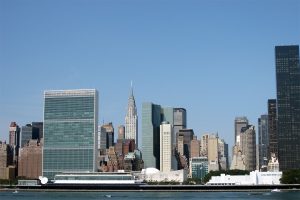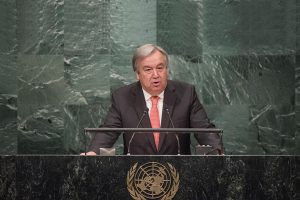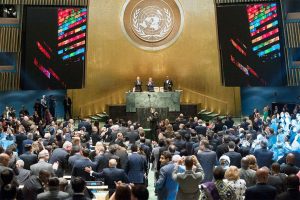26 April 2019: A UN system task team has prepared a common narrative for six high-level events taking place in September 2019. UN Secretary-General Antonio Guterres informally presented the narrative document to governments to support preparations for the meetings.
The narrative describes the series of meetings as a singular world gathering with a three-fold aim of taking stock of progress, increasing ambition, and highlighting “scalable, just and tailored” solutions to global challenges.
The meetings are:
- The General Debate of the UN General Assembly’s (UNGA) 74th session;
- The Climate Action Summit being convened by the Secretary-General;
- The UN High-level Political Forum on Sustainable Development (HLPF) convening under UNGA auspices (also known as the SDG Summit);
- The UNGA’s high-level meeting on universal health coverage (UHC);
- The UNGA’s high-level dialogue on financing for development (FfD); and
- The UNGA’s high-level review of the SAMOA Pathway on sustainable development for small island developing States (SIDS).
In a letter accompanying the narrative, Guterres informs Member States that he asked the UN system’s HLPF Task Team to produce the document following some Member States’ call for coherence among the meetings and a “unifying narrative” that would help with implementation of the agreements reached in 2015. In 2015, UN governments adopted the Paris Agreement on climate change, the 2030 Agenda on Sustainable Development containing the 17 SDGs, and the Addis Ababa Action Agenda on FfD.
The three-page document identifies connections and commonalities among the meetings, noting that all are aimed at “inspiring ambitious action to end poverty, respond to the climate threat and secure healthy, peaceful and prosperous lives for all.” In addition, each meeting embodies the “central principles” of the 2030 Agenda, namely universality, leaving no one behind, and a strengthened global partnership. Specific interconnections among the meetings are seen as:
- The climate and UHC meetings address threats to people’s wellbeing, especially for the most vulnerable;
- The General Debate and HLPF will take stock of the 2030 Agenda, while the FfD Dialogue will seek to boost resources to achieve that Agenda; and
- The SAMOA Pathway review and the high-level week as a whole will bring focus to the world’s most vulnerable countries.
In a section on taking stock, the authors highlight that a range of actors has taken SDG and climate action and initiatives in the past four years. For example, cities and local authorities have led a global movement for transformation, 75% of UN Member States have presented a voluntary national review of SDG implementation, 182 countries have submitted nationally determined contributions (NDCs) under the Paris Agreement on climate change, and the UN development system is undergoing reforms to better support countries in implementing the 2030 Agenda.
The SDG Summit is envisioned as the launchpad for a decade of delivery.
As areas of SDG progress, the document points to successes on poverty and access to health, education and basic infrastructure. More problematic trends relate to displacement, conflict and inequality, as well as hunger, wages, gender inequalities, and “runaway climate change” and unsustainable consumption and production. These trends’ worst effects are felt by the poorest and most vulnerable, the document says. It adds that financing for SDG achievement remains a major challenge.
Following this stocktaking, the narrative document sets out a vision for the high-level week. Beginning on Monday, 23 September, the Climate Action Summit could set the tone for the week by generating a surge in ambition and spotlighting impactful solutions. Also on Monday, the UHC meeting will highlight links between health and climate, and health as a “precondition, outcome and driver” of sustainable development.
The SDG Summit taking place on Tuesday and Wednesday, 24-25 September, is envisioned as the setting to review the global response to the 2030 Agenda, and as the launchpad for a “decade of delivery.” On Thursday, the FfD dialogue will bring forward initiatives to unlock resources, building on the FfD Forum in April 2019, which was convened by the UN Economic and Social Council (ECOSOC).
Finally, the SAMOA review is expected to draw links to climate and ocean issues, resilience, non-communicable diseases (NCDs) and resource mobilization. It will also serve to “judge our progress in delivering on the promises we made to SIDS.” In this regard, the review meeting can measure the fulfillment of commitments to the furthest behind, and this is an important indicator for the 2030 Agenda as a whole. As the Task Team writes, “only if we reach the SDGs in SIDS and in other vulnerable countries, will we have succeeded to deliver on the 2030 Agenda overall.”
Closing the document with a section on “a reinvigorated response,” the authors envision leaders returning to their countries from the high-level week “emboldened” both by fellow governments’ actions and by the availability of concrete, scalable solutions.
The authors also highlight the meetings’ potential to harness the power and commitment of children and young people, as well as coalitions among different actors and new forms of collaboration. As seen by the Task Team, the high-level week could mark a shift not just from commitments to action, but also “onwards to results.”
The Secretary-General notes that Member States and others are invited to draw on the narrative as they deem appropriate. The UN system’s HLPF Task Team is co-chaired by the UN Department of Economic and Social Affairs (DESA) and the UN Development Programme (UNDP). [Letter of Secretary-General]





